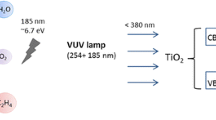Abstract
Ethylene is an undesirable compound for the storage of horticultural products. The traditional fresh-keeping method of fruits and vegetables is refrigeration. However, even in refrigeration environment, ethylene is released by horticultural products themselves or other sources. The residual ethylene can accelerate maturation and corruption of horticultural products and thus should better be wiped away. The technique of dielectric barrier discharge was applied to decompose ethylene. Under electric discharge, many energetic and highly reactive species can be produced, which can react with and decompose the chemical compounds in contact with them. In this study, the efficiency of ethylene removal using dielectric barrier discharge reactor was studied. Ethylene removal rates were affected by many factors, such as gas discharge gap, wire distance, flow rate, ethylene initial concentration and humidity. The kinetics of ethylene removal was studied. To disintegrate ethylene, the optimal discharge gap was 3 mm, wire distance 0.5 mm, gas flow rate 3.5 L min−1 and humidity 61 %. Two kinetics models were selected for ethylene decomposition, and experimental results could fit the model with a maximum absolute error of 4 %. With optimal discharge condition, ethylene can totally be removed. In the future, decomposition of ethylene by dielectric barrier discharge technology will be a promising method to keep fruits and vegetables fresh.










Similar content being viewed by others
References
Bai YH, Chen JR, Yang Y (2010) Degradation of organophosphorus pesticide induced by oxygen plasma: effects of operating parameters and reaction mechanisms. Chemosphere 81:408–414
Chung JW, Cho MH, Son BH (2000) Study on reduction of energy consumption in pulsed corona discharge process for NO(x) removal. Plasma Chem Plasma Process 20:495–509
Eschbach P, Griffin J, Reed N (2000) Ethylene concentrations in controlled atmosphere storage. In: 16th annual postharvest conference, Yakima, WA, pp 14–15
Fridman A (2008) Plasma chemistry. Cambridge University Press, Cambridge, pp 10–12
Grabowski LR, Van VEM, Pemen AJM (2007) Breakdown of methylene blue and methyl orange by pulsed corona discharge. Plasma Sources Sci Technol 16:226–232
Guo YF, Ye DQ, Chen KF, Tian YF (2006) Humidity effect on toluene decomposition in a wire-plate dielectric barrier discharge reactor. Plasma Chem Plasma Process 26:237–249
Huang HB, Ye DQ (2009) Combination of photocatalysis downstream the nonthermal plasma reactor for oxidation of gas-phase toluene. J Hazard Mater 171:535–541
Indarto A (2012) Decomposition of dichlorobenzene in a dielectric barrier discharge. Environ Technol 33:663–666
Jarrige J, Vervisch P (2007) Decomposition of gaseous sulfide compounds in air by pulsed corona discharge. Plasma Process 27:241–255
Liang WJ, Li J, Li J (2009) Abatement of toluene from gas streams via ferro-electric packed bed dielectric barrier discharge plasma. J Hazard Mater 170:633–638
Liu ZX, Cho MW (2006) Removal of ethylene over KMnO(4)/Al(2)O(3)-SiO(2). Bull Korean Chem Soc 27:2064–2066
Mario MS, Axel V, Esteban S, Jacques A (2008) Design of a DBD wire-cylinder reactor for NOx emission control: experimental and modelling approach. J Clean Prod 16:198–207
Mizuno A (2007) Industrial applications of atmospheric non-thermal plasma in environmental remediation. Plasma Phys Controll Fusion 49:1–15
Nathan R, Altman A, Monselise SP (1984) Changes in activity of polyamine biosynthetic-enzymes and in polyamine contents in developing fruit tissues of Murcott mandarin. Sci Hortic 22:359–364
Oda T (2003) Non-thermal plasma processing for environmental protection: decomposition of dilute VOCs in air. J Electrostat 57:293–311
Peng LT, Jiang YM, Jiang WB (2002) Ethylene control horticultural crops research progress. J Chin Food Sci 23:132–136
Raju BR, Reddy EL, Karuppiah J, Reddy PMK, Subrahmanyam C (2013) Catalytic non-thermal plasma reactor for the decomposition of a mixture of volatile organic compounds. J Chem Sci 125:673–678
Rosocha LA, Korzekwa RA (1999) Advanced oxidation and reduction processes in the gas phase using non-thermal plasmas. J Adv Oxid Technol 4:247–264
Rudolph R, Francke KP, Miessner H (2002) Concentration dependence of VOC decomposition by dielectric barrier discharges. Plasma Chem Plasma Process 22:401–412
Saltveit ME (1999) Effect of ethylene on quality of fresh fruits and vegetables. Postharvest Biol Technol 15:279–292
Sun QD (2007) Applications of photocatalized TiO2 to ethylene removal and freshness-holdable storage of vegetables and fruits. Vacuum 44:63–65
Van Durme J, Dewulf J, Sysmans W (2007) Abatement and degradation pathways of toluene in indoor air by positive corona discharge. Chemosphere 68:1821–1829
Van Durme J, Dewulf J, Demeestere K (2009) Post-plasma catalytic technology for the removal of toluene from indoor air: effect of humidity. Appl Catal B Environ 87:78–83
Vandenbroucke AM, Morent R, De Geyter N (2011) Decomposition of trichloroethylene with plasma-catalysis: a review. J Adv Oxid Technol 14:165–173
Vandenbroucke AM, Morent R, De Geyter N, Leys C (2012) Decomposition of toluene with plasma-catalysis: a review. J Adv Oxid Technol 15:232–241
Yan K, Van Heesch EJM, Pemen AJM (2001) From chemical kinetics to streamer corona reactor and voltage pulse generator. Plasma Chem Plasma Process 21:107–137
Zhao Q, Liu SZ, Tong HH (2009) Plasma technology and its application. National Defense Industry Press, Beijing, pp 40–41
Acknowledgments
This research was financially supported by the program of Detection and Control of Spoilage Organisms and Pesticide Residues in Agricultural Products (PXM2012_014207_000011) and Innovative Platform Construction Team of Agricultural Products Safety and Pesticide Residue Analysis. This work was also supported by Shenzhen Science and Technology Project (Grant No. JC200903180677A) and Science and Technology Project of General Administration of Quality Supervision, Inspection and Quarantine (AQSIQ) (Grant No. 2013IK052), China.
Author information
Authors and Affiliations
Corresponding author
Rights and permissions
About this article
Cite this article
Ma, T.J., Lan, W.S. Ethylene decomposition with a wire-plate dielectric barrier discharge reactor: parameters and kinetic study. Int. J. Environ. Sci. Technol. 12, 3951–3956 (2015). https://doi.org/10.1007/s13762-015-0799-9
Received:
Revised:
Accepted:
Published:
Issue Date:
DOI: https://doi.org/10.1007/s13762-015-0799-9




